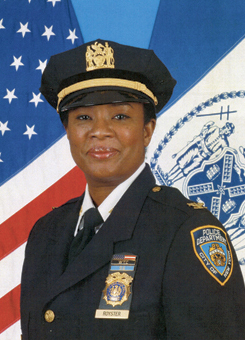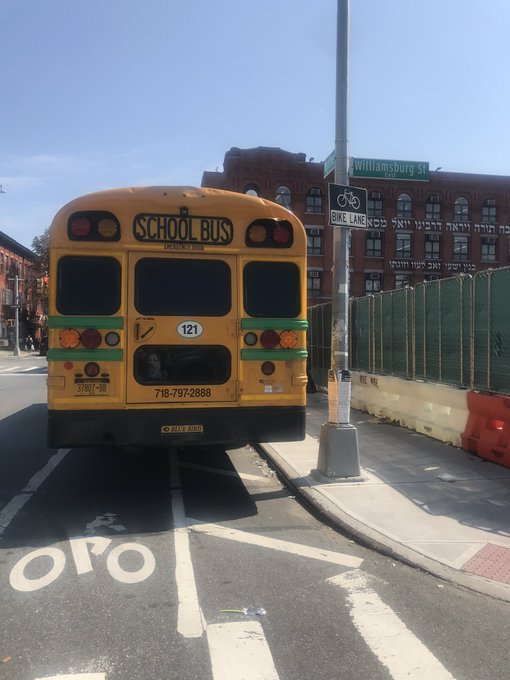The NYPD’s Fourth of July safety plan includes both protecting cyclists, and punishing them in ways that have long been racially biased.

NYPD Transportation Bureau Chief Kim Royster, who took over in November, announced on Thursday cops’ plan to crack down on reckless and drunk drivers ahead of the holiday weekend celebrating the slave-owning Founding Fathers' 18th-century break from England — a traditionally dangerous weekend for vulnerable road users, with the potential to only be made worse by the speeding epidemic that took off at the start of the pandemic.
Royster also trumpeted a backwards approach to safety by telling bikers to keep off the sidewalk — a minor transgression for which the NYPD has disproportionately ticketed Black and Brown riders.
“Cyclists are our most vulnerable. So we are continuing to make sure that people that park in bus lanes, as well as bike lanes are actually summonsed, and also we’re making sure that we prevent them from riding on sidewalks because it’s their safety, too, not just pedestrian safety,” said Royster in response to a question at a presser that also featured Department of Transportation Commissioner Hank Gutman and Taxi and Limousine Commissioner Aloysee Heredia Jarmoczuk.
Today, @NYPDTransport, along with @NYC_DOT , @nyctaxi, and @BrianKavanaghNY, spoke about traffic enforcement during the upcoming holiday weekend.
— NYPD NEWS (@NYPDnews) July 1, 2021
Watch the full press conference here 🔽https://t.co/YPRkIBnujj
But Royster’s own rank and file officers have a history of targeting Black and Brown cyclists for biking on the sidewalk, slapping them with criminal court summonses for, what is typically, a means of just trying to avoid a blocked bike lane or street where they feel unsafe riding.

Streetsblog reported last year that police had issued 440 tickets for biking on the sidewalk in 2018 and 2019, and 374 — or 86.4 percent — of those where race was listed went to Black and Hispanic New Yorkers. The number of tickets issued to Black and Hispanic bikers is wildly disproportionate, given that they comprise only 49 percent of cyclists, according to the Department of Transportation. And during the same 24 months, police issued White cyclists just 39 tickets for riding on the sidewalk — only 9 percent of the total number of tickets where race was indicated. The DOT says White cyclists comprise 40 percent of all bikers in the city.
The racially discriminatory ticket stats followed a 2014 Streetsblog report, which revealed that of the 15 neighborhoods where police handed out the most summonses for cycling on the sidewalk, 12 were mostly Black or Latino.
What cyclists needs more than being hauled into court for riding on the sidewalk under the guise of their own safety is actually safe, protected bike lanes, according to Transportation Alternatives, which argued in a report last summer that protected bike lanes help facilitate as much as a 94-percent drop in cycling on the sidewalk.
“If people are riding bikes on the sidewalk, it’s because there’s no safe place to ride in the street. Handing out tickets doesn’t build protected bike lanes,” said a former spokesman for Transportation Alternatives. “Our resources would be so much better spent on designing and building safe streets, not harassing Black men for trying to get from A to B safely.”
So far this year, seven cyclists have been killed on the streets of New York City, along with hundreds more injured. The latest fatality happened on Tuesday, when 71-year-old Upper West Sider Jeffrey Williamson was struck by a postal service truck driver as he was riding on Central Park West near West 86th Street — a notoriously dangerous intersection where cyclists have long complained that the unprotected crossing makes them vulnerable to turning motorists.
In addition to the cyclist crackdown, Royster said her cops will be out in force in every precinct across the city, with officers on the ground who are specially trained to detect and take action against drunk and impaired drivers, along with speedsters. But previous NYPD enforcement stings have so far proven undeterring to stop the same reckless behavior again and again. Last spring, during the height of the pandemic, Streetsblog revealed how few speeding tickets cops were writing despite the promise of a crackdown.
And in 2019, the NYPD touted a weeks-long crackdown that resulted in roughly the same number of speeding tickets handed out as the year before. Cops did write more failure-to-yield tickets, and more tickets to drivers for blocking the bike lane, Streetsblog reported, but even those increases amounted to roughly four tickets per day per precinct.






